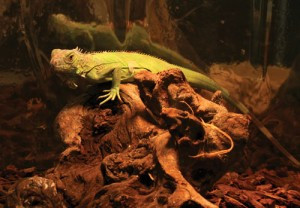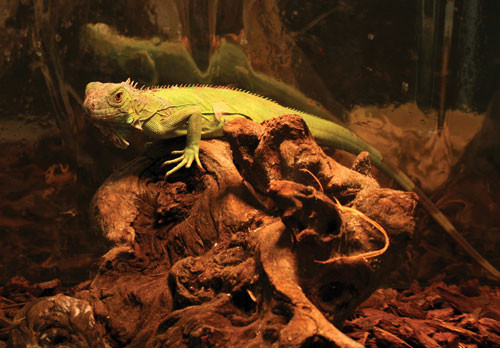Colorful Foundations
Erik J. Martin //March 17, 2014//
Got a listless lizard in your store? Instead of being tired or sick, maybe he just woke up on the wrong side of the substrate. Which begs a bedding question: What reptile cage bottom contents are you using in your retail displays and recommending to customers?
Reptile bedding materials have come a long way from the days when chocolate and vanilla, aka bark and sand, were the only two primary options for sale. Today, there’s more variety than ever before, as reflected in expanded product choices, brands, natural sources and colors.
Case in point: glow-in-the-dark calcium carbonate sand, as offered by RepTerra. The newest color in the manufacturer’s premium sand series really pops when the lights go out, perfect to create a buzz with kids and families. 
Also available in permaglo pink, granite red, slickrock red, white, black, purple, green and blue, this product is designed to reduce impaction problems common among reptiles that are housed on silica sand, wood shavings and other substrates, and is safe for desert species of snakes and lizards, along with tortoises. The right colored sand can create eye-catching contrast in a habitat and liven up an otherwise bland display.
Natural Options
Herp bedding has long focused on replicating naturalistic substrates that mirror the animal’s native environment. It’s a big reason why, for example, sand isn’t going out of style anytime soon for adult desert species. But manufacturers are also incorporating more eco-friendly features in their offerings nowadays, as evidenced by an increase in biodegradable bedding products and substrates made from sustainable materials, such as paper pellets sourced from recycled newspaper.
Zoo Med’s Eco Earth Loose Coconut Fiber Substrate, for instance, ties into the naturalistic terrarium theme. Boasting an “all-natural green product,” this bedding is made from the husks of coconuts and can be safely recycled into gardens or potted plants, or composted.
Another example is Exo Terra’s Coco Husk Terrarium Substrate, ideal for tropical terrariums housing salamanders and frogs, and comprised of compressed coconut husk from tropical Asian plantations. The product not only increases humidity in the habitat, but stimulates natural burrowing and digging activity.
Zilla makes a worthy sand alternative that can also be easily composted. Ground English Walnut Shells Desert Blend for desert critters serves, which serves as an outstanding heat conductor, while also encouraging instinctual digging and burrowing behavior. If you’re worried about herps walking on jagged walnut shells, relax, the shells are ground to a uniform size.
Everyone Has a Favorite
Ask Charlie Soto, manager of Jules Pet Shop in Chicago, which reptile substrate he prefers using and stocking and he’ll tell you it’s Aspen all the way. These scent-free shavings remain the utilitarian cage liner of choice for many retailers and pet owners alike. The likners are highly absorbent for easy cleaning, applicable for most species of lizards, snakes and tortoises sold by pet stores, almost entirely dust-free for hypoallergenic safety, and void of any hazardous oils often found in other wood-based bedding.
“Yes, there’s a lot more substrate choices today than years ago, but Aspen is the top seller in our store,” Soto, said., adding that his customers are shifting from bark and sand to Aspen in growing numbers. “In our store, attractive substrate colors and hot new bedding products on the market aren’t what excite pet owners; they’re more concerned about low price, which can make Aspen appealing.”
Douglas Matuszak, owner of Boa Basement, a Cleveland-based reptile breeder, agrees that Aspen is a safe, all-purpose choice.
“It’s an effective moisture absorber, and it makes spot cleanups easy within the cage. Our animals seem to thrive on it,” Matuszak said. “But whatever substrate you use or carry, you want to stay away from any large chunks with coarse edges, as they’re not conducive to nesting and breeding and can cause impaction. Do your homework, as certain species can react badly to certain bedding materials.”
Owners can react badly to substrates, too, which is why Robert Walter, co-owner of Reptile Island, a retailer with three locations in Southern California, recently switched from alfalfa pellets to paper pellets for desert species.
“When water spilled on the alfalfa pellets, it would sometimes get moldy and smell bad, which you don’t want in your store,” Walter, whose top selling substrate is Zoo Med’s Repti Bark, said.
Soto says it’s smart to showcase different substrate products in your setups and live reptile displays.
“The customer’s got to see it in use,” Soto said. “Plus, it’s a good way to show off a bit of color. But it’s important to change your bedding around, don’t use the same thing all the time in the same displays. And make sure your staff is educated about the features and benefits of these products in case shoppers ask.”
Walter said that, although bedding is not the most exciting product in a retailer’s lineup, “it can be a strong seller for you if you promote it right. You should try to offer a good variety of brands and be in an educated position to know what’s best for the animal, not just the products on your shelf that you want to push.”



















